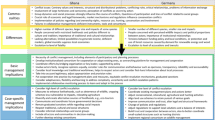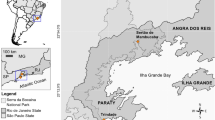Abstract
The national park model originating in the unique circumstances of mid-19th century North America has been widely applied in the developing countries of the late 20th century, provoking numerous land-use conflicts between parks and resident peoples. Key factors in understanding these conflicts are examined using the field experience of the Ranomafana National Park in Madagascar. A conflict management strategy is suggested for alleviating such antagonism and facilitating the investigation of mutually acceptable conservation and development pathways.
Similar content being viewed by others
References
Bohlen, J. T. (1993). For the Wild Places: Profiles in Conservation. Washington, DC: Island Press.
Brady, N. C. (1996). “Alternatives to slash-and-burn: a global imperative,” Agriculture, Ecosystems and Environment 58: 3-11.
Brandon, K. E. and M. Wells (1992). “Planning for people and parks: design dilemmas,” World Development 20(4): 557-570.
Brechin, S. R., P. C. West, D. Harmon, and K. Kutay (1991). “Resident peoples and protected areas: a framework for inquiry,” in P. C. West and S. R. Brechin (eds.), Resident Peoples and National Parks: Social Dilemmas and Strategies in International Conservation (pp. 5-28). Tucson: University of Arizona Press.
Brody, J. E. (1998). “Saving Madagascar's bounty for its lemurs and its people,” The New York Times, August 11, 1998.
Colchester, M. (1996). “Beyond 'participation': indigenous peoples, biological diversity conservation and protected area management,” Unasylva 186: 33-39.
DEF/ANGAP (1992). Manuel de procedure pour la creation des aires protégées. Antananarivo: Direction des Eaux et Forêts/Association Nationale pour la Gestion des Aires Protégées.
Ferraro, P. (1994). Natural Resource Use in the Southeastern Rain Forests of Madagascar and the Local Impacts of Establishing the Ranomafana National Park. Masters Thesis. Durham: Duke University.
Ferraro, P. and B. Rakotondrajaona (1992). “Preliminary assessment of local population forest use, forestry initiatives, agricultural operations, cultural diversity, and the potential for rural development in the region of the Ranomafana National Park, 1990–1991,” in Ranomafana National Park Project (ed.), Socio-Economic Surveys in the Ranomafana National Park Periphery (pp. 78-129). Durham: Duke University.
Green, G. M. and R. W. Sussman (1990). “Deforestation history of the eastern rain forests of Madagascar from satellite images,” Science 248: 211-215.
Hale, E. (1989). “Report from Madagascar: island at risk,” USA Today, October 4, 1989.
Hanson, P. W. (1996). Coming to Terms with the People of Madagascar. WWW: MCA, Inc.
Harmon, D. (1987). “Cultural diversity, human subsistence, and the national park ideal,” Environmental Ethics: 147-158.
Harmon, D. (1991). “National park residency in developed countries: the example of Great Britain,” in P. C. West and S. R. Brechin (eds.), Resident Peoples and National Parks: Social Dilemmas and Strategies in International Conservation (pp. 33-39). Tucson: University of Arizona Press.
Harper, J. (1997). “In their sights: the role of the independent researcher working near a development project.” A paper presented at the Society for Applied Anthropology Annual Meeting, March 4–9, 1997.
Hough, J. L. (1988). “Obstacles to effective management of conflicts between national parks and surrounding human communities in developing countries,” Environmental Conservation 15(2): 129-136.
IAI-TPTF (1992). Charter of the Indigenous-Tribal Peoples of the Tropical Forests. Penang: International Alliance of the Indigenous-Tribal Peoples of the Tropical Forests.
IUCN (1978). Categories, Objectives and Criteria for Protected Areas: A Final Report. Morges: International Union for Conservation of Nature and Natural Resources.
IUCN (1985). United Nations List of National Parks and Protected Areas. Gland: International Union for Conservation of Nature and Natural Resources.
Jarosz, L. (1993). “Defining and explaining tropical deforestation: shifting cultivation and population growth in Colonial Madagascar (1896–1940),” Economic Geography 69(4): 366-379.
Johnson, B. (1993). “Soil survey,” in D. del Castillo (ed.), Final Report for the Agricultural Development Component of the Ranomafana National Park Project in Madagascar (pp. 5-10). Raleigh: North Carolina State University.
Jolly, A. (1989). “The Madagascar challenge: human needs and fragile ecosystems,” in H. J. Leonard, and Contributors (eds.), Environment and the Poor: Development Strategies for a Common Agenda (pp. 190-203). New Brunswick and Oxford: Transaction Books.
Keck, A., N. Sharma, and G. Feder (1994). Population Growth, Shifting Cultivation, and Unsustainable Agricultural Development: A Case Study in Madagascar. World Bank Discussion Series 234. Washington, DC: World Bank.
Kull, C. A. (1996). “The evolution of conservation efforts in Madagascar,” International Environmental Affairs 8(1): 50-86.
Lehmkuhl, J. F., R. K. Upreti, and U. R. Sharma (1988). “National parks and local development: grasses and people in Royal Chitwan National Park, Nepal,” Environmental Conservation 15(2): 143-148.
MPAEF (1991). Decret N° 91-250, portant création du Parc National N° 4 de Ranomafana dans les Fivondronampokontany d'Ifanadiana, de Fianarantsoa II et d'Ambohimahasoa, Faritany de Fianarantsoa. Antananarivo: Ministère de la Production Animale (Elevage et Pêche) et des Eaux et Forêts, Repoblika Demokratika Malagasy.
Neumann, R. P. and G. E. Machlis (1989). “Land-use and threats to parks in the neotropics,” Environmental Conservation 16(1): 13-18.
Oxby, C. (1985). “Forest farmers: the transformation of land use and society in eastern Madagascar,” Unasylva 37(148): 42-51.
Peters, D. (1992). “A sociological/anthropological study of two Tanala and two Betsileo villages,” in Socio-Economic Surveys in the Ranomafana National Park Periphery. Ranomafana National Park Project (pp. 158-238). Durham: Duke University.
Peters, D. (1995). Human Dimensions of Natural Resource Management: A Case Study of Ranomafana National Park, Madagascar. Ph.D. Dissertation. Raleigh: North Carolina State University.
Peters, J. (1997). “Local participation in the conservation of the Ranomafana National Park, Madagascar,” Journal of World Forest Resources Management 8(2): 109-135.
Peters, J. (1998). “Sharing national park entrance fees: forging new partnerships in Madagascar,” Society and Natural Resources 11(5): 517-530.
Peters, W. J. and L. F. Neuenschwander (1988). Slash and Burn: Farming in the Third World Forest. Moscow: University of Idaho Press.
Rao, K. and C. Geisler (1990). “The social consequences of protected areas development for resident populations,” Society and Natural Resources 3: 19-32.
Reid, W. V. and K. R. Miller (1989). Keeping Options Alive: The Scientific Basis for Conserving Biodiversity. Washington, DC: World Resources Institute.
Stone, R. D. (1991). Wildlands and Human Needs: Reports from the Field. Washington, DC: World Wildlife Fund.
Tichnell, D. L., G. E. Machlis, and J. R. Fazio (1983), “Threats to national parks: a preliminary survey,” Parks 8(1): 14-17.
USAID (1992). Madagascar CPSP: Country Program Strategic Plan FY 1993–1998. Antananarivo: US Agency for International Development.
Wellman, J. D. (1987). Wildland Recreation Policy: An Introduction. Malabar: Kreiger Publishing.
Wells, M. and K. Brandon, with L. Hannah (1992). People and Parks: Linking Protected Area Management with Local Communities. Washington, DC: World Bank, World Wildlife Fund, and US Agency for International Development.
Author information
Authors and Affiliations
Rights and permissions
About this article
Cite this article
Peters, J. Understanding Conflicts between People and Parks at Ranomafana, Madagascar. Agriculture and Human Values 16, 65–74 (1999). https://doi.org/10.1023/A:1007572011454
Published:
Issue Date:
DOI: https://doi.org/10.1023/A:1007572011454




